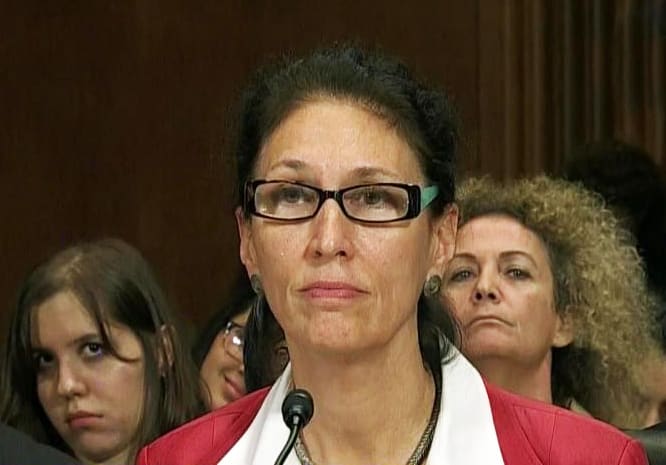The Trump administration is likely to set the United States’ ceiling for admitting refugees at approximately half of what it was last year, according to two knowledgeable former Trump administration officials and several refugee advocates familiar with internal debates. And last year’s quota was the lowest level for refugees since 1980—all while a migration crisis unfolds worldwide.
The administration doesn’t officially have a refugee number set on paper yet, sources said, and officials don’t have to reach a formal decision until September. But they’re sending signals internally and to outside interlocutors that the next year’s cap on refugee admissions will be between 20,000 and 25,000 people, according to these ex-officials and advocates. That’s about half of the 45,000-refugee ceiling the Trump administration set last year, and four to five times lower than the Obama administration’s final-year refugee ceiling of 110,000.
“I feel like it’s a really dark moment, so fundamentally un-American,” said Barbara Strack, who until January 2018 was a senior Department of Homeland Security official overseeing refugee admissions.

CSPAN
Strack and other ex-officials say they’re worried about a downward spiral in the United States’ ability to admit vulnerable people fleeing dire conditions of war, extreme poverty, persecution, or natural disaster. Lowered admissions ceilings can lead to the U.S. cutting off resources for resettling refugees, which can in turn prompt anti-refugee officials to cite the diminished capacity for lowering the ceilings further—sparking a structural degeneration in infrastructure for admitting refugees that threatens to outlive the Trump administration.
“We’ve completely abandoned leadership [on refugees] and a commitment to their protection at a time when world needs couldn’t be higher,” Strack added. “That’s not a good national security posture. There’s a fundamental notion of otherness for refugees, as opposed to saying ‘There but for the grace of God go I.’”
For those involved in the administration’s restrictionist approach to refugees and those who work to mitigate it, the likely lowered next ceiling represents a victory for White House senior policy adviser Stephen Miller. Miller, an immigration hardliner, has exerted substantial influence in the administration’s refugee and migration debates despite not having a formal brief for foreign policy or national security.
“The determining factor here is the desire among policymakers in this administration to drive the refugee admission program down to very small numbers, if not wipe it out entirely,” said Steve Pomper, a human-rights official on Barack Obama’s National Security Council.
Last September, the Trump administration set a refugee admissions quota of 45,000, severely down from its Obama administration predecessor. That followed President Trump’s January and March 2017 executive orders, which declared that admitting more than 50,000 refugees “would be detrimental to the interests of the United States.”
During internal debates, three knowledgeable current and former officials say, Miller and his allies pushed for even lower numbers on refugee admissions—as low as 15,000 refugees. To push back, career officials responsible for refugee vetting and admissions used Trump’s stated 50,000 quota as an anchor and ended up adopting 45,000 as the highest amount possible.
They described a chaotic process that angered key legislators of both parties with belated notification to Capitol Hill. “It is simply unacceptable to read in the press that the administration had reached its decision on the refugee cap before the mandated meeting with Congress had even been scheduled,” Sens. Chuck Grassley and Dianne Feinstein said in a joint Sept. 27 statement.
But the 45,000 ceiling was just that: a ceiling. For the past several months, it’s been clear that the actual total admissions will fall closer to the floor. State Department refugee data extrapolated to the end of September, when the fiscal year turns over, indicate that the U.S. will actually admit something like 20,000 to 21,000 refugees.
That’s not because of any decline in the number of people seeking refuge in the United States. It’s thanks to a raft of self-imposed bureaucratic restrictions, resulting in “a huge slowdown in refugee admissions,” said Nazanin Ash, vice president for policy at the International Rescue Committee, one of the State Department’s nine contracted agencies for resettling refugees.

via Twitter
Several former administration officials and refugee advocates described that bureaucratic morass. The Muslim-ban executive orders led to pauses in refugee processing. Refugee processing officials were diverted to perform asylum processing functions, even though the administration already had authorities and money to increase asylum capacity. Security processing at the FBI for refugees slowed from hundreds of cases a week to single digits. Refugees undergoing screening had to provide contact information for a larger number of relatives, even if those relatives were neither in the U.S. nor sought to be, as well as residential information going back for a longer period.
All of that strained a process that can take two years to complete—leading in some cases to the expiration of vetting data while people languished in the queue. And the administration’s changes were retroactive, meaning that already-vetted people now had to meet new requirements.
“By making this retroactive, you’re essentially putting people back in the the back of the line and making them start over,” Ash said.
Another consequence is that the diminished admissions, four knowledgeable sources said, are expected to become the new ceiling. Discussions within the Trump administration, these sources related, are already treating a ceiling of 20,000 to 25,000 as a fait accompli, ahead of the unveiling of next fiscal year’s refugee ceiling, anticipated in September.
“I think it’s very likely that’s going to be the new ceiling,” said Strack, the former senior DHS refugee official. She said the refugee ceiling could even be lower.
During last year’s contentious internal negotiations, relative moderates like acting Homeland Security Secretary Elaine Duke, Secretary of State Rex Tillerson, and DHS Assistant Secretary James Nealon were able to push back against Miller and his allies. All are now gone. In their place are relative hardliners like DHS Secretary Kirstjen Nielsen, Secretary of State Mike Pompeo, and senior State Department migration official Andrew Veprek.
“Falling short of this year’s ceiling is the result of political decisions, not operational shortcomings,” Strack said. “In contrast to the last administration, there was no political will from the White House to achieve the ceiling and to troubleshoot the inevitable challenges as they arise.”
Falling short also has consequences—consequences that can outlast the Trump administration.
Reductions in refugee admissions while the ceiling drops can result in diminished resources for resettlement, such as shuttering resettlement offices and getting rid of staff. Then, when the cuts come, advocates and ex-officials fear, refugee hardliners can use that to argue for dropping the ceiling further on the claim that the U.S. doesn’t have sufficient capacity for resettlement. The State Department’s nine contracted agencies for resettlement are already bracing for the ax: In March, it put those agencies on notice that the department next year “expects to fund a smaller number of recipient agencies.” In February, Reuters reported that dozens of resettlement offices were preparing to close or downsize.
That capacity can be difficult to regenerate. The first two years after 9/11 saw refugee admissions drop to around 21,000 and 27,000 annually—even though George W. Bush’s administration kept the ceiling at 70,000 throughout. The drop was to a great degree a function of overhauled vetting and security procedures at ports of entry to the U.S. that came as part of the preparatory work for creating the Department of Homeland Security. Even though the drop wasn’t a matter of policy, it still took “10 years to build back up to the capacity that we had prior to 9/11, in terms of the admissions level meeting the ceiling,” Ash said.
Miller, as well as press officials from the White House and Department of Homeland Security, did not respond to requests for comment as of press time. The FBI declined to comment.
A State Department spokesperson did not dispute The Daily Beast’s reporting and said: “Through the U.S. Refugee Admissions Program, the United States has offered new beginnings to more than 3.3 million refugees since 1975—more than any other country in the world. The United States will continue to resettle the most vulnerable refugees while prioritizing the safety and security of the American people.”

Jim Young/Getty
The lowering of the refugee ceiling is of a piece with the Trump administration’s broader immigration restrictions. Trump ended the Central American Minors program that reunited mostly children from El Salvador, Guatemala, and Honduras with relatives legally residing in the U.S., and processed them in their country of origin for safe transport to the U.S. He ended Temporary Protected Status for tens of thousands of Hondurans, Salvadorans, Haitians, Nicaraguans, Nepalese, and Sudanese people, subjecting them to deportation. He’s treated asylum seeking as functionally criminal, despite U.S. law, and made legal immigration harder to obtain—all while calling undocumented immigrants vermin that “infest” America. Not only did Trump’s “zero tolerance” policy forcibly separate approximately 3,000 children from their parents, his administration also has offered their families reunification through deportation. And his administration plans to establish internment camps on military bases for up to 32,000 families and children.
“This is essentially a manufactured crisis. To use it to say ‘we don’t need all that capacity next year’ is a self-fulfilling prophecy,” said Mary Giovagnoli, a senior immigration official at the Department of Homeland Security during the Obama administration and the current executive director of Refugee Council USA, an umbrella group of refugee resettlement and advocacy groups.
“The longer this kind of delay in the cycle goes on, the more likely it is we’ll lose the capacity to welcome refugees when this or another administration realizes we should be doing more. Expertise gets lost, people move on, and it becomes increasingly difficult to rebuild.”
—with additional reporting by Asawin Suebsaeng

